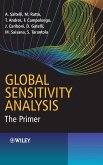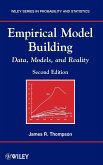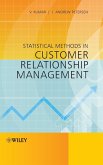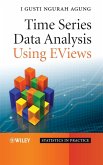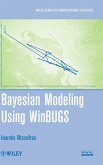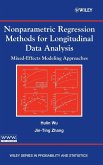I Gusti Ngurah Agung
Panel Data Analysis Using Eviews
I Gusti Ngurah Agung
Panel Data Analysis Using Eviews
- Gebundenes Buch
- Merkliste
- Auf die Merkliste
- Bewerten Bewerten
- Teilen
- Produkt teilen
- Produkterinnerung
- Produkterinnerung
A comprehensive and accessible guide to panel data analysis using EViews software
This book explores the use of EViews software in creating panel data analysis using appropriate empirical models and real datasets. Guidance is given on developing alternative descriptive statistical summaries for evaluation and providing policy analysis based on pool panel data. Various alternative models based on panel data are explored, including univariate general linear models, fixed effect models and causal models, and guidance on the advantages and disadvantages of each one is given.
Panel Data…mehr
Andere Kunden interessierten sich auch für
![Global Sensitivity Analysis Global Sensitivity Analysis]() Andrea SaltelliGlobal Sensitivity Analysis128,99 €
Andrea SaltelliGlobal Sensitivity Analysis128,99 €![Sensitivity Analysis Sensitivity Analysis]() Andrea SaltelliSensitivity Analysis92,99 €
Andrea SaltelliSensitivity Analysis92,99 €![Empirical Model Building Empirical Model Building]() James R. ThompsonEmpirical Model Building156,99 €
James R. ThompsonEmpirical Model Building156,99 €![Statistical Methods in Customer Relationship Management Statistical Methods in Customer Relationship Management]() V. KumarStatistical Methods in Customer Relationship Management111,99 €
V. KumarStatistical Methods in Customer Relationship Management111,99 €![Time Series Data Analysis Using Eviews Time Series Data Analysis Using Eviews]() I. Gusti Ngurah AgungTime Series Data Analysis Using Eviews179,99 €
I. Gusti Ngurah AgungTime Series Data Analysis Using Eviews179,99 €![Bayesian Modeling Using WinBUGS Bayesian Modeling Using WinBUGS]() Ioannis NtzoufrasBayesian Modeling Using WinBUGS173,99 €
Ioannis NtzoufrasBayesian Modeling Using WinBUGS173,99 €![Nonparametric Regression Methods for Longitudinal Data Analysis Nonparametric Regression Methods for Longitudinal Data Analysis]() Hulin WuNonparametric Regression Methods for Longitudinal Data Analysis165,99 €
Hulin WuNonparametric Regression Methods for Longitudinal Data Analysis165,99 €-
-
-
A comprehensive and accessible guide to panel data analysis using EViews software
This book explores the use of EViews software in creating panel data analysis using appropriate empirical models and real datasets. Guidance is given on developing alternative descriptive statistical summaries for evaluation and providing policy analysis based on pool panel data. Various alternative models based on panel data are explored, including univariate general linear models, fixed effect models and causal models, and guidance on the advantages and disadvantages of each one is given.
Panel Data Analysis using EViews:
Provides step-by-step guidance on how to apply EViews software to panel data analysis using appropriate empirical models and real datasets.
Examines a variety of panel data models along with the author's own empirical findings, demonstrating the advantages and limitations of each model.
Presents growth models, time-related effects models, and polynomial models, in addition to the models which are commonly applied for panel data.
Includes more than 250 examples divided into three groups of models (stacked, unstacked, and structured panel data), together with notes and comments.
Provides guidance on which models not to use in a given scenario, along with advice on viable alternatives.
Explores recent new developments in panel data analysis
An essential tool for advanced undergraduate or graduate students and applied researchers in finance, econometrics and population studies. Statisticians and data analysts involved with data collected over long time periods will also find this book a useful resource.
This book explores the use of EViews software in creating panel data analysis using appropriate empirical models and real datasets. Guidance is given on developing alternative descriptive statistical summaries for evaluation and providing policy analysis based on pool panel data. Various alternative models based on panel data are explored, including univariate general linear models, fixed effect models and causal models, and guidance on the advantages and disadvantages of each one is given.
Panel Data Analysis using EViews:
Provides step-by-step guidance on how to apply EViews software to panel data analysis using appropriate empirical models and real datasets.
Examines a variety of panel data models along with the author's own empirical findings, demonstrating the advantages and limitations of each model.
Presents growth models, time-related effects models, and polynomial models, in addition to the models which are commonly applied for panel data.
Includes more than 250 examples divided into three groups of models (stacked, unstacked, and structured panel data), together with notes and comments.
Provides guidance on which models not to use in a given scenario, along with advice on viable alternatives.
Explores recent new developments in panel data analysis
An essential tool for advanced undergraduate or graduate students and applied researchers in finance, econometrics and population studies. Statisticians and data analysts involved with data collected over long time periods will also find this book a useful resource.
Produktdetails
- Produktdetails
- Verlag: Wiley & Sons
- 1. Auflage
- Seitenzahl: 544
- Erscheinungstermin: 3. Februar 2014
- Englisch
- Abmessung: 249mm x 193mm x 30mm
- Gewicht: 1066g
- ISBN-13: 9781118715581
- ISBN-10: 1118715586
- Artikelnr.: 38480808
- Herstellerkennzeichnung
- Libri GmbH
- Europaallee 1
- 36244 Bad Hersfeld
- gpsr@libri.de
- Verlag: Wiley & Sons
- 1. Auflage
- Seitenzahl: 544
- Erscheinungstermin: 3. Februar 2014
- Englisch
- Abmessung: 249mm x 193mm x 30mm
- Gewicht: 1066g
- ISBN-13: 9781118715581
- ISBN-10: 1118715586
- Artikelnr.: 38480808
- Herstellerkennzeichnung
- Libri GmbH
- Europaallee 1
- 36244 Bad Hersfeld
- gpsr@libri.de
I Gusti Ngurah Agung, Graduate School of Management, Faculty of Economics and Business, University of Indonesia
Preface xv
About the Author xxi
PART ONE PANEL DATA AS A MULTIVARIATE TIME SERIES BY STATES 1
1 Data Analysis Based on a Single Time Series by States 3
1.1 Introduction 3
1.2 Multivariate Growth Models 3
1.3 Alternative Multivariate Growth Models 10
1.4 Various Models Based on Correlated States 14
1.5 Seemingly Causal Models with Time-Related Effects 21
1.6 The Application of the Object POOL 23
1.7 Growth Models of Sample Statistics 29
1.8 Special Notes on Time-State Observations 32
1.9 Growth Models with an Environmental Variable 32
1.10 Models with an Environmental Multivariate 40
1.11 Special Piece-Wise Models 49
2 Data Analysis Based on Bivariate Time Series by States 55
2.1 Introduction 55
2.2 Models Based on Independent States 56
2.3 Time-Series Models Based on Two Correlated States 60
2.4 Time-Series Models Based on Multiple Correlated States 72
2.5 Time-Series Models with an Environmental Variable Zt, Based on
Independent States 78
2.6 Models Based on Correlated States 82
2.7 Piece-Wise Time-Series Models 86
3 Data Analysis Based on Multivariate Time Series by States 87
3.1 Introduction 87
3.2 Models Based on (X_i,Y_i,Z_i) for Independent States 88
3.3 Models Based on (X_i, Y_i,Z_i) for Correlated States 90
3.4 Simultaneous SCMs with Trend 96
3.5 Models Based on (X1_i,X2_i,X3_i, Y1_i,Y2_i) for Independent States 100
3.6 Models Based on (X_i,Y_i) for Correlated States 103
3.7 Discontinuous Time-Series Models 106
3.8 Additional Examples for Correlated States 107
3.9 Special Notes and Comments 109
4 Applications of Seemingly Causal Models 111
4.1 Introduction 111
4.2 SCMs Based on a Single Time Series Y_it 112
4.3 SCMs Based on Bivariate Time Series (X_it,Y_it) 118
4.4 SCMs Based on a Trivariate (X1_i,X2_i,Y1_i) 120
4.5 SCMs Based on a Trivariate (X_it,Y1_it,Y2_it) 126
4.6 SCMs Based on Multivariate Endogenous and Exogenous Variables 127
4.7 Fixed- and Random Effects Models 133
4.8 Models with Cross-Section Specific Coefficients 138
4.9 Cases in Industry 146
PART TWO POOL PANEL DATA ANALYSIS 149
5 Evaluation Analysis 151
5.1 Introduction 151
5.2 Preliminary Evaluation Analysis 152
5.3 The Application of the Object "Descriptive Statistics and Tests" 153
5.4 Analysis Based on Ordinal Problem Indicators 158
5.5 Multiple Association between Categorical Variables 161
6 General Choice Models 165
6.1 Introduction 165
6.2 Multi-Factorial Binary Choice Models 165
6.3 Binary Logit Model of Yit on a Numerical Variable Xit 175
6.4 Binary Logit Model of a Zero-One Indicator Yit on (X1it,X2it) 182
6.5 Binary Choice Model of a Zero-One Indicator Yit on (X1it,X2it,X3it) 187
6.6 Binary Choice Model of a Zero-One Indicator Yit on (X1it,. . ., Xhit,.
. .) 190
6.7 Special Notes and Comments 190
7 Advanced General Choice Models 192
7.1 Introduction 192
7.2 Categorical Data Analyses 193
7.3 Multi-Factorial Choice Models with a Numerical Independent Variable 207
8 Univariate General Linear Models 216
8.1 Introduction 216
8.2 ANOVA and Quantile Models 216
8.3 Continuous Linear-Effect Models 221
8.4 Piece-Wise Autoregressive Linear Models by Time Points 227
8.5 ANCOVA Models 241
9 Fixed-Effects Models and Alternatives 244
9.1 Introduction 244
9.2 Cross-Section Fixed-Effects Models 245
9.3 Time-Fixed-Effects Models 251
9.4 Two-Way Fixed-Effects Models 254
9.5 Extended Fixed-Effects Models 265
9.6 Selected Fixed-Effects Models from the Journal of Finance, 2011 274
9.7 Heterogeneous Regression Models 278
10 Special Notes on Selected Problems 286
10.1 Introduction 286
10.2 Problems with Dummy Variables 286
10.3 Problems with the Numerical Variable Rit 288
10.4 Problems with the First Difference Variable 294
10.5 Problems with Ratio Variables 295
10.6 The CAPM and its Extensions or Modifications 298
10.7 Selected Heterogeneous Regressions from International Journals 305
10.8 Models without the Time-Independent Variable 308
10.9 Models with Time Dummy Variables 311
10.10 Final Remarks 312
11 Seemingly Causal Models 314
11.1 Introduction 314
11.2 MANOVA Models 314
11.3 Multivariate Heterogeneous Regressions by Group and Time 315
11.4 MANCOVA Models 318
11.5 Discontinuous and Continuous MGLM by Time 319
11.6 Illustrative Linear-Effect Models by Times 319
11.7 Illustrative SCMs by Group and Time 331
PART THREE BALANCED PANEL DATA AS NATURAL
EXPERIMENTAL DATA 337
12 Univariate Lagged Variables Autoregressive Models 339
12.1 Introduction 339
12.2 Developing Special Balanced Pool Data 339
12.3 Natural Experimental Data Analysis 341
12.4 The Simplest Heterogeneous Regressions 343
12.5 LVAR(1,1) Heterogeneous Regressions 344
12.6 Manual Stepwise Selection for General Linear LV(1) Model 362
12.7 Manual Stepwise Selection for Binary Choice LV(1) Models 369
12.8 Manual Stepwise Selection for Ordered Choice Models 378
12.9 Bounded Models by Group and Time 387
13 Multivariate Lagged Variables Autoregressive Models 396
13.1 Introduction 396
13.2 Seemingly Causal Models 396
13.3 Alternative Data Analyses 400
13.4 SCMs Based on (Y1,Y2) 401
13.5 Advanced Autoregressive SCMs 421
13.6 SCMs Based on (Y1,Y2) with Exogenous Variables 430
14 Applications of GLS Regressions 441
14.1 Introduction 441
14.2 Cross-Section Random Effects Models (CSREMs) 441
14.3 LV(1) CSREMs by Group or Time 443
14.4 CSREMs with the Numerical Time Variable 448
14.5 CSREMs by Time or Time Period 454
14.6 Period Random Effects Models (PEREMs) 463
14.7 Illustrative Panel Data Analysis Based on CES.wf1 465
14.8 Two-Way Effects Models 468
14.9 Testing Hypotheses 473
14.10 Generalized Method of Moments/Dynamic Panel Data 482
14.11 More Advanced Interaction Effects Models 489
References 501
Index 509
About the Author xxi
PART ONE PANEL DATA AS A MULTIVARIATE TIME SERIES BY STATES 1
1 Data Analysis Based on a Single Time Series by States 3
1.1 Introduction 3
1.2 Multivariate Growth Models 3
1.3 Alternative Multivariate Growth Models 10
1.4 Various Models Based on Correlated States 14
1.5 Seemingly Causal Models with Time-Related Effects 21
1.6 The Application of the Object POOL 23
1.7 Growth Models of Sample Statistics 29
1.8 Special Notes on Time-State Observations 32
1.9 Growth Models with an Environmental Variable 32
1.10 Models with an Environmental Multivariate 40
1.11 Special Piece-Wise Models 49
2 Data Analysis Based on Bivariate Time Series by States 55
2.1 Introduction 55
2.2 Models Based on Independent States 56
2.3 Time-Series Models Based on Two Correlated States 60
2.4 Time-Series Models Based on Multiple Correlated States 72
2.5 Time-Series Models with an Environmental Variable Zt, Based on
Independent States 78
2.6 Models Based on Correlated States 82
2.7 Piece-Wise Time-Series Models 86
3 Data Analysis Based on Multivariate Time Series by States 87
3.1 Introduction 87
3.2 Models Based on (X_i,Y_i,Z_i) for Independent States 88
3.3 Models Based on (X_i, Y_i,Z_i) for Correlated States 90
3.4 Simultaneous SCMs with Trend 96
3.5 Models Based on (X1_i,X2_i,X3_i, Y1_i,Y2_i) for Independent States 100
3.6 Models Based on (X_i,Y_i) for Correlated States 103
3.7 Discontinuous Time-Series Models 106
3.8 Additional Examples for Correlated States 107
3.9 Special Notes and Comments 109
4 Applications of Seemingly Causal Models 111
4.1 Introduction 111
4.2 SCMs Based on a Single Time Series Y_it 112
4.3 SCMs Based on Bivariate Time Series (X_it,Y_it) 118
4.4 SCMs Based on a Trivariate (X1_i,X2_i,Y1_i) 120
4.5 SCMs Based on a Trivariate (X_it,Y1_it,Y2_it) 126
4.6 SCMs Based on Multivariate Endogenous and Exogenous Variables 127
4.7 Fixed- and Random Effects Models 133
4.8 Models with Cross-Section Specific Coefficients 138
4.9 Cases in Industry 146
PART TWO POOL PANEL DATA ANALYSIS 149
5 Evaluation Analysis 151
5.1 Introduction 151
5.2 Preliminary Evaluation Analysis 152
5.3 The Application of the Object "Descriptive Statistics and Tests" 153
5.4 Analysis Based on Ordinal Problem Indicators 158
5.5 Multiple Association between Categorical Variables 161
6 General Choice Models 165
6.1 Introduction 165
6.2 Multi-Factorial Binary Choice Models 165
6.3 Binary Logit Model of Yit on a Numerical Variable Xit 175
6.4 Binary Logit Model of a Zero-One Indicator Yit on (X1it,X2it) 182
6.5 Binary Choice Model of a Zero-One Indicator Yit on (X1it,X2it,X3it) 187
6.6 Binary Choice Model of a Zero-One Indicator Yit on (X1it,. . ., Xhit,.
. .) 190
6.7 Special Notes and Comments 190
7 Advanced General Choice Models 192
7.1 Introduction 192
7.2 Categorical Data Analyses 193
7.3 Multi-Factorial Choice Models with a Numerical Independent Variable 207
8 Univariate General Linear Models 216
8.1 Introduction 216
8.2 ANOVA and Quantile Models 216
8.3 Continuous Linear-Effect Models 221
8.4 Piece-Wise Autoregressive Linear Models by Time Points 227
8.5 ANCOVA Models 241
9 Fixed-Effects Models and Alternatives 244
9.1 Introduction 244
9.2 Cross-Section Fixed-Effects Models 245
9.3 Time-Fixed-Effects Models 251
9.4 Two-Way Fixed-Effects Models 254
9.5 Extended Fixed-Effects Models 265
9.6 Selected Fixed-Effects Models from the Journal of Finance, 2011 274
9.7 Heterogeneous Regression Models 278
10 Special Notes on Selected Problems 286
10.1 Introduction 286
10.2 Problems with Dummy Variables 286
10.3 Problems with the Numerical Variable Rit 288
10.4 Problems with the First Difference Variable 294
10.5 Problems with Ratio Variables 295
10.6 The CAPM and its Extensions or Modifications 298
10.7 Selected Heterogeneous Regressions from International Journals 305
10.8 Models without the Time-Independent Variable 308
10.9 Models with Time Dummy Variables 311
10.10 Final Remarks 312
11 Seemingly Causal Models 314
11.1 Introduction 314
11.2 MANOVA Models 314
11.3 Multivariate Heterogeneous Regressions by Group and Time 315
11.4 MANCOVA Models 318
11.5 Discontinuous and Continuous MGLM by Time 319
11.6 Illustrative Linear-Effect Models by Times 319
11.7 Illustrative SCMs by Group and Time 331
PART THREE BALANCED PANEL DATA AS NATURAL
EXPERIMENTAL DATA 337
12 Univariate Lagged Variables Autoregressive Models 339
12.1 Introduction 339
12.2 Developing Special Balanced Pool Data 339
12.3 Natural Experimental Data Analysis 341
12.4 The Simplest Heterogeneous Regressions 343
12.5 LVAR(1,1) Heterogeneous Regressions 344
12.6 Manual Stepwise Selection for General Linear LV(1) Model 362
12.7 Manual Stepwise Selection for Binary Choice LV(1) Models 369
12.8 Manual Stepwise Selection for Ordered Choice Models 378
12.9 Bounded Models by Group and Time 387
13 Multivariate Lagged Variables Autoregressive Models 396
13.1 Introduction 396
13.2 Seemingly Causal Models 396
13.3 Alternative Data Analyses 400
13.4 SCMs Based on (Y1,Y2) 401
13.5 Advanced Autoregressive SCMs 421
13.6 SCMs Based on (Y1,Y2) with Exogenous Variables 430
14 Applications of GLS Regressions 441
14.1 Introduction 441
14.2 Cross-Section Random Effects Models (CSREMs) 441
14.3 LV(1) CSREMs by Group or Time 443
14.4 CSREMs with the Numerical Time Variable 448
14.5 CSREMs by Time or Time Period 454
14.6 Period Random Effects Models (PEREMs) 463
14.7 Illustrative Panel Data Analysis Based on CES.wf1 465
14.8 Two-Way Effects Models 468
14.9 Testing Hypotheses 473
14.10 Generalized Method of Moments/Dynamic Panel Data 482
14.11 More Advanced Interaction Effects Models 489
References 501
Index 509
Preface xv
About the Author xxi
PART ONE PANEL DATA AS A MULTIVARIATE TIME SERIES BY STATES 1
1 Data Analysis Based on a Single Time Series by States 3
1.1 Introduction 3
1.2 Multivariate Growth Models 3
1.3 Alternative Multivariate Growth Models 10
1.4 Various Models Based on Correlated States 14
1.5 Seemingly Causal Models with Time-Related Effects 21
1.6 The Application of the Object POOL 23
1.7 Growth Models of Sample Statistics 29
1.8 Special Notes on Time-State Observations 32
1.9 Growth Models with an Environmental Variable 32
1.10 Models with an Environmental Multivariate 40
1.11 Special Piece-Wise Models 49
2 Data Analysis Based on Bivariate Time Series by States 55
2.1 Introduction 55
2.2 Models Based on Independent States 56
2.3 Time-Series Models Based on Two Correlated States 60
2.4 Time-Series Models Based on Multiple Correlated States 72
2.5 Time-Series Models with an Environmental Variable Zt, Based on
Independent States 78
2.6 Models Based on Correlated States 82
2.7 Piece-Wise Time-Series Models 86
3 Data Analysis Based on Multivariate Time Series by States 87
3.1 Introduction 87
3.2 Models Based on (X_i,Y_i,Z_i) for Independent States 88
3.3 Models Based on (X_i, Y_i,Z_i) for Correlated States 90
3.4 Simultaneous SCMs with Trend 96
3.5 Models Based on (X1_i,X2_i,X3_i, Y1_i,Y2_i) for Independent States 100
3.6 Models Based on (X_i,Y_i) for Correlated States 103
3.7 Discontinuous Time-Series Models 106
3.8 Additional Examples for Correlated States 107
3.9 Special Notes and Comments 109
4 Applications of Seemingly Causal Models 111
4.1 Introduction 111
4.2 SCMs Based on a Single Time Series Y_it 112
4.3 SCMs Based on Bivariate Time Series (X_it,Y_it) 118
4.4 SCMs Based on a Trivariate (X1_i,X2_i,Y1_i) 120
4.5 SCMs Based on a Trivariate (X_it,Y1_it,Y2_it) 126
4.6 SCMs Based on Multivariate Endogenous and Exogenous Variables 127
4.7 Fixed- and Random Effects Models 133
4.8 Models with Cross-Section Specific Coefficients 138
4.9 Cases in Industry 146
PART TWO POOL PANEL DATA ANALYSIS 149
5 Evaluation Analysis 151
5.1 Introduction 151
5.2 Preliminary Evaluation Analysis 152
5.3 The Application of the Object "Descriptive Statistics and Tests" 153
5.4 Analysis Based on Ordinal Problem Indicators 158
5.5 Multiple Association between Categorical Variables 161
6 General Choice Models 165
6.1 Introduction 165
6.2 Multi-Factorial Binary Choice Models 165
6.3 Binary Logit Model of Yit on a Numerical Variable Xit 175
6.4 Binary Logit Model of a Zero-One Indicator Yit on (X1it,X2it) 182
6.5 Binary Choice Model of a Zero-One Indicator Yit on (X1it,X2it,X3it) 187
6.6 Binary Choice Model of a Zero-One Indicator Yit on (X1it,. . ., Xhit,.
. .) 190
6.7 Special Notes and Comments 190
7 Advanced General Choice Models 192
7.1 Introduction 192
7.2 Categorical Data Analyses 193
7.3 Multi-Factorial Choice Models with a Numerical Independent Variable 207
8 Univariate General Linear Models 216
8.1 Introduction 216
8.2 ANOVA and Quantile Models 216
8.3 Continuous Linear-Effect Models 221
8.4 Piece-Wise Autoregressive Linear Models by Time Points 227
8.5 ANCOVA Models 241
9 Fixed-Effects Models and Alternatives 244
9.1 Introduction 244
9.2 Cross-Section Fixed-Effects Models 245
9.3 Time-Fixed-Effects Models 251
9.4 Two-Way Fixed-Effects Models 254
9.5 Extended Fixed-Effects Models 265
9.6 Selected Fixed-Effects Models from the Journal of Finance, 2011 274
9.7 Heterogeneous Regression Models 278
10 Special Notes on Selected Problems 286
10.1 Introduction 286
10.2 Problems with Dummy Variables 286
10.3 Problems with the Numerical Variable Rit 288
10.4 Problems with the First Difference Variable 294
10.5 Problems with Ratio Variables 295
10.6 The CAPM and its Extensions or Modifications 298
10.7 Selected Heterogeneous Regressions from International Journals 305
10.8 Models without the Time-Independent Variable 308
10.9 Models with Time Dummy Variables 311
10.10 Final Remarks 312
11 Seemingly Causal Models 314
11.1 Introduction 314
11.2 MANOVA Models 314
11.3 Multivariate Heterogeneous Regressions by Group and Time 315
11.4 MANCOVA Models 318
11.5 Discontinuous and Continuous MGLM by Time 319
11.6 Illustrative Linear-Effect Models by Times 319
11.7 Illustrative SCMs by Group and Time 331
PART THREE BALANCED PANEL DATA AS NATURAL
EXPERIMENTAL DATA 337
12 Univariate Lagged Variables Autoregressive Models 339
12.1 Introduction 339
12.2 Developing Special Balanced Pool Data 339
12.3 Natural Experimental Data Analysis 341
12.4 The Simplest Heterogeneous Regressions 343
12.5 LVAR(1,1) Heterogeneous Regressions 344
12.6 Manual Stepwise Selection for General Linear LV(1) Model 362
12.7 Manual Stepwise Selection for Binary Choice LV(1) Models 369
12.8 Manual Stepwise Selection for Ordered Choice Models 378
12.9 Bounded Models by Group and Time 387
13 Multivariate Lagged Variables Autoregressive Models 396
13.1 Introduction 396
13.2 Seemingly Causal Models 396
13.3 Alternative Data Analyses 400
13.4 SCMs Based on (Y1,Y2) 401
13.5 Advanced Autoregressive SCMs 421
13.6 SCMs Based on (Y1,Y2) with Exogenous Variables 430
14 Applications of GLS Regressions 441
14.1 Introduction 441
14.2 Cross-Section Random Effects Models (CSREMs) 441
14.3 LV(1) CSREMs by Group or Time 443
14.4 CSREMs with the Numerical Time Variable 448
14.5 CSREMs by Time or Time Period 454
14.6 Period Random Effects Models (PEREMs) 463
14.7 Illustrative Panel Data Analysis Based on CES.wf1 465
14.8 Two-Way Effects Models 468
14.9 Testing Hypotheses 473
14.10 Generalized Method of Moments/Dynamic Panel Data 482
14.11 More Advanced Interaction Effects Models 489
References 501
Index 509
About the Author xxi
PART ONE PANEL DATA AS A MULTIVARIATE TIME SERIES BY STATES 1
1 Data Analysis Based on a Single Time Series by States 3
1.1 Introduction 3
1.2 Multivariate Growth Models 3
1.3 Alternative Multivariate Growth Models 10
1.4 Various Models Based on Correlated States 14
1.5 Seemingly Causal Models with Time-Related Effects 21
1.6 The Application of the Object POOL 23
1.7 Growth Models of Sample Statistics 29
1.8 Special Notes on Time-State Observations 32
1.9 Growth Models with an Environmental Variable 32
1.10 Models with an Environmental Multivariate 40
1.11 Special Piece-Wise Models 49
2 Data Analysis Based on Bivariate Time Series by States 55
2.1 Introduction 55
2.2 Models Based on Independent States 56
2.3 Time-Series Models Based on Two Correlated States 60
2.4 Time-Series Models Based on Multiple Correlated States 72
2.5 Time-Series Models with an Environmental Variable Zt, Based on
Independent States 78
2.6 Models Based on Correlated States 82
2.7 Piece-Wise Time-Series Models 86
3 Data Analysis Based on Multivariate Time Series by States 87
3.1 Introduction 87
3.2 Models Based on (X_i,Y_i,Z_i) for Independent States 88
3.3 Models Based on (X_i, Y_i,Z_i) for Correlated States 90
3.4 Simultaneous SCMs with Trend 96
3.5 Models Based on (X1_i,X2_i,X3_i, Y1_i,Y2_i) for Independent States 100
3.6 Models Based on (X_i,Y_i) for Correlated States 103
3.7 Discontinuous Time-Series Models 106
3.8 Additional Examples for Correlated States 107
3.9 Special Notes and Comments 109
4 Applications of Seemingly Causal Models 111
4.1 Introduction 111
4.2 SCMs Based on a Single Time Series Y_it 112
4.3 SCMs Based on Bivariate Time Series (X_it,Y_it) 118
4.4 SCMs Based on a Trivariate (X1_i,X2_i,Y1_i) 120
4.5 SCMs Based on a Trivariate (X_it,Y1_it,Y2_it) 126
4.6 SCMs Based on Multivariate Endogenous and Exogenous Variables 127
4.7 Fixed- and Random Effects Models 133
4.8 Models with Cross-Section Specific Coefficients 138
4.9 Cases in Industry 146
PART TWO POOL PANEL DATA ANALYSIS 149
5 Evaluation Analysis 151
5.1 Introduction 151
5.2 Preliminary Evaluation Analysis 152
5.3 The Application of the Object "Descriptive Statistics and Tests" 153
5.4 Analysis Based on Ordinal Problem Indicators 158
5.5 Multiple Association between Categorical Variables 161
6 General Choice Models 165
6.1 Introduction 165
6.2 Multi-Factorial Binary Choice Models 165
6.3 Binary Logit Model of Yit on a Numerical Variable Xit 175
6.4 Binary Logit Model of a Zero-One Indicator Yit on (X1it,X2it) 182
6.5 Binary Choice Model of a Zero-One Indicator Yit on (X1it,X2it,X3it) 187
6.6 Binary Choice Model of a Zero-One Indicator Yit on (X1it,. . ., Xhit,.
. .) 190
6.7 Special Notes and Comments 190
7 Advanced General Choice Models 192
7.1 Introduction 192
7.2 Categorical Data Analyses 193
7.3 Multi-Factorial Choice Models with a Numerical Independent Variable 207
8 Univariate General Linear Models 216
8.1 Introduction 216
8.2 ANOVA and Quantile Models 216
8.3 Continuous Linear-Effect Models 221
8.4 Piece-Wise Autoregressive Linear Models by Time Points 227
8.5 ANCOVA Models 241
9 Fixed-Effects Models and Alternatives 244
9.1 Introduction 244
9.2 Cross-Section Fixed-Effects Models 245
9.3 Time-Fixed-Effects Models 251
9.4 Two-Way Fixed-Effects Models 254
9.5 Extended Fixed-Effects Models 265
9.6 Selected Fixed-Effects Models from the Journal of Finance, 2011 274
9.7 Heterogeneous Regression Models 278
10 Special Notes on Selected Problems 286
10.1 Introduction 286
10.2 Problems with Dummy Variables 286
10.3 Problems with the Numerical Variable Rit 288
10.4 Problems with the First Difference Variable 294
10.5 Problems with Ratio Variables 295
10.6 The CAPM and its Extensions or Modifications 298
10.7 Selected Heterogeneous Regressions from International Journals 305
10.8 Models without the Time-Independent Variable 308
10.9 Models with Time Dummy Variables 311
10.10 Final Remarks 312
11 Seemingly Causal Models 314
11.1 Introduction 314
11.2 MANOVA Models 314
11.3 Multivariate Heterogeneous Regressions by Group and Time 315
11.4 MANCOVA Models 318
11.5 Discontinuous and Continuous MGLM by Time 319
11.6 Illustrative Linear-Effect Models by Times 319
11.7 Illustrative SCMs by Group and Time 331
PART THREE BALANCED PANEL DATA AS NATURAL
EXPERIMENTAL DATA 337
12 Univariate Lagged Variables Autoregressive Models 339
12.1 Introduction 339
12.2 Developing Special Balanced Pool Data 339
12.3 Natural Experimental Data Analysis 341
12.4 The Simplest Heterogeneous Regressions 343
12.5 LVAR(1,1) Heterogeneous Regressions 344
12.6 Manual Stepwise Selection for General Linear LV(1) Model 362
12.7 Manual Stepwise Selection for Binary Choice LV(1) Models 369
12.8 Manual Stepwise Selection for Ordered Choice Models 378
12.9 Bounded Models by Group and Time 387
13 Multivariate Lagged Variables Autoregressive Models 396
13.1 Introduction 396
13.2 Seemingly Causal Models 396
13.3 Alternative Data Analyses 400
13.4 SCMs Based on (Y1,Y2) 401
13.5 Advanced Autoregressive SCMs 421
13.6 SCMs Based on (Y1,Y2) with Exogenous Variables 430
14 Applications of GLS Regressions 441
14.1 Introduction 441
14.2 Cross-Section Random Effects Models (CSREMs) 441
14.3 LV(1) CSREMs by Group or Time 443
14.4 CSREMs with the Numerical Time Variable 448
14.5 CSREMs by Time or Time Period 454
14.6 Period Random Effects Models (PEREMs) 463
14.7 Illustrative Panel Data Analysis Based on CES.wf1 465
14.8 Two-Way Effects Models 468
14.9 Testing Hypotheses 473
14.10 Generalized Method of Moments/Dynamic Panel Data 482
14.11 More Advanced Interaction Effects Models 489
References 501
Index 509


